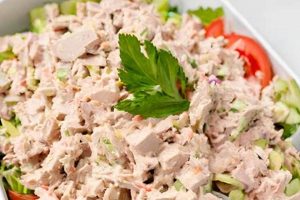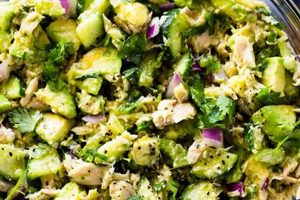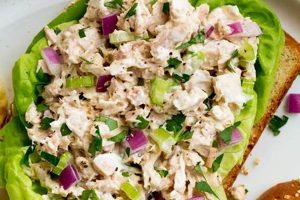A healthier twist on the classic tuna salad replaces mayonnaise with Greek yogurt. This substitution creates a lighter dish with a tangy flavor profile while also increasing the protein content and reducing overall fat. This variation often includes traditional ingredients like celery, onion, and seasonings, but also allows for creative additions such as grapes, walnuts, or apples for added texture and flavor complexity.
Using Greek yogurt offers significant nutritional advantages. It boasts a higher protein content compared to mayonnaise, contributing to satiety and muscle maintenance. Simultaneously, it significantly reduces the calorie and fat content, making it a suitable option for those seeking healthier meal choices. The tangy flavor of the yogurt complements the tuna, creating a refreshing and palatable experience. This adaptable recipe can be enjoyed as a sandwich filling, a lettuce wrap, or a standalone dish.
The following sections will delve into specific recipe variations using Greek yogurt as a base, exploring diverse flavor combinations and offering practical tips for preparation and storage. Nutritional information will also be provided to highlight the health benefits of this contemporary take on a beloved classic.
Tips for Greek Yogurt Tuna Salad
Optimizing a Greek yogurt tuna salad recipe involves careful consideration of ingredient selection and preparation techniques. These tips ensure a flavorful, healthy, and enjoyable culinary experience.
Tip 1: Yogurt Selection: Opt for plain, non-fat Greek yogurt. Flavored varieties often contain added sugars, which can detract from the desired flavor profile. The thick texture of Greek yogurt provides the ideal consistency for tuna salad.
Tip 2: Tuna Choice: Canned tuna packed in water offers a leaner protein source compared to oil-packed alternatives. Solid or chunk light tuna works well, providing a satisfying texture.
Tip 3: Enhancing Flavor: Fresh herbs, such as dill or chives, elevate the flavor profile. A squeeze of lemon juice adds brightness and complements the tangy yogurt. Spices like paprika or celery seed provide depth and complexity.
Tip 4: Texture Considerations: Finely diced celery and red onion contribute a satisfying crunch. For added texture and flavor, consider incorporating chopped walnuts, apples, or grapes.
Tip 5: Ingredient Ratios: Start with a 1:1 ratio of Greek yogurt to tuna. Adjust the amount of yogurt based on preferred consistency. Adding yogurt gradually prevents an overly runny salad.
Tip 6: Chilling Time: Allow the salad to chill for at least 30 minutes before serving. This allows the flavors to meld and enhances the overall taste experience.
Tip 7: Storage: Store leftover tuna salad in an airtight container in the refrigerator for up to three days.
By following these tips, one can create a delicious and nutritious tuna salad that offers a healthy alternative to traditional mayonnaise-based recipes. The result is a satisfying dish perfect for a light lunch, snack, or appetizer.
These guidelines provide a solid foundation for crafting a personalized Greek yogurt tuna salad recipe tailored to individual preferences.
1. Healthy Alternative
The concept of “healthy alternative” finds a compelling example in the substitution of Greek yogurt for mayonnaise in tuna salad. This shift reflects a broader dietary trend towards reducing fat and increasing protein intake, while maintaining flavor and satisfaction. This section explores the facets of this healthy alternative, specifically within the context of tuna salad preparation.
- Reduced Fat Content
Mayonnaise, a traditional tuna salad ingredient, is high in fat. Greek yogurt, on the other hand, offers a significantly lower fat content, particularly when using non-fat varieties. This reduction contributes to a lower overall calorie count, making Greek yogurt tuna salad a more suitable option for those managing weight or cholesterol levels.
- Increased Protein Intake
Greek yogurt provides a substantial protein boost compared to mayonnaise. This increased protein content contributes to feelings of satiety, which can assist in appetite control and weight management. The higher protein content also supports muscle maintenance and repair.
- Enhanced Nutritional Value
Beyond protein, Greek yogurt offers additional nutritional benefits. It is a source of calcium, which is essential for bone health, and probiotics, which contribute to gut health. These nutritional advantages further solidify its position as a healthy alternative to mayonnaise in tuna salad.
- Versatile Flavor Profile
While offering distinct tangy notes, Greek yogurt’s relatively neutral flavor profile allows it to blend seamlessly with other tuna salad ingredients. This versatility permits diverse flavor combinations, accommodating both traditional and innovative recipe variations.
The convergence of reduced fat, increased protein, enhanced nutritional value, and versatile flavor establishes Greek yogurt as a viable and appealing healthy alternative to mayonnaise in tuna salad. This substitution not only aligns with contemporary health-conscious dietary preferences but also expands the culinary possibilities within this classic dish.
2. Ingredient Ratios
Ingredient ratios significantly influence the final texture, flavor, and overall quality of a Greek yogurt tuna salad. A balanced approach ensures a harmonious blend of components, creating a palatable and enjoyable culinary experience. This section examines key facets of ingredient ratios specific to this recipe.
- Yogurt to Tuna Ratio
The foundational ratio in Greek yogurt tuna salad involves the balance between yogurt and tuna. A 1:1 ratio, equal parts yogurt and tuna, generally provides a desirable consistency. However, individual preferences may dictate adjustments. A higher yogurt ratio yields a creamier, tangier salad, while a higher tuna ratio results in a denser, more savory profile. Recipe adjustments should be made incrementally to achieve the desired texture and taste.
- Flavor Enhancer Ratios
Flavor enhancers, including celery, onion, herbs, and spices, contribute significantly to the overall taste profile. These ingredients should be added judiciously. Too much celery or onion can overpower the delicate flavor of the tuna and yogurt. Similarly, an excess of herbs or spices can create an unbalanced flavor profile. Start with small amounts and adjust according to personal preference.
- Texture Modifier Ratios
Ingredients that modify texture, such as chopped nuts, grapes, or apples, introduce textural complexity. However, an excessive amount can shift the focus from the tuna and yogurt, creating a salad that feels more like a fruit or nut salad. Consider these additions as accents, contributing to the overall experience without dominating the primary flavors.
- Liquid Component Ratios
Liquid components, like lemon juice, can affect the salad’s consistency. Too much liquid can result in a runny texture. If using lemon juice or other liquids, add them sparingly, considering the moisture content already present in the yogurt and other ingredients. Careful attention to liquid ratios prevents an undesirable watery consistency.
Careful consideration of these ingredient ratios ensures a balanced and enjoyable Greek yogurt tuna salad. A harmonious blend of flavors and textures contributes to a satisfying culinary experience. Experimentation within these ratio guidelines allows for personalized adjustments based on individual preferences.
3. Flavor Enhancements
Flavor enhancements play a crucial role in elevating Greek yogurt tuna salad from a simple combination of ingredients to a complex and satisfying culinary creation. Strategic additions of herbs, spices, and other flavoring agents transform the basic recipe, creating a dynamic taste experience. This section explores key flavor enhancement strategies within the context of Greek yogurt tuna salad.
- Fresh Herbs
Fresh herbs provide a vibrant and aromatic dimension to tuna salad. Dill, chives, and parsley are particularly complementary, offering bright, herbaceous notes that contrast with the richness of the tuna and the tanginess of the yogurt. Finely chopped herbs blend seamlessly into the salad, infusing each bite with fresh flavor. The quantity of herbs used can be adjusted based on personal preference, but a light hand is generally recommended to avoid overpowering the other flavors.
- Spices
Spices offer a deeper, more nuanced layer of flavor. Paprika adds a subtle smokiness, while celery seed provides a savory depth. A pinch of black pepper adds a touch of piquancy. Experimenting with different spice combinations allows for customized flavor profiles, ranging from mildly seasoned to boldly spiced. As with herbs, moderation is key to prevent the spices from dominating the overall taste.
- Citrus Zest and Juice
Citrus zest and juice introduce a bright, acidic element that cuts through the richness of the tuna and yogurt. Lemon zest and juice are commonly used, adding a refreshing citrusy note. Lime or orange zest and juice can also be incorporated for alternative citrus profiles. The acidity not only enhances the flavor but also helps to balance the overall taste profile.
- Other Flavoring Agents
Beyond herbs, spices, and citrus, other flavoring agents can contribute unique dimensions to the tuna salad. A small amount of Dijon mustard adds a tangy complexity. Finely chopped capers provide a briny, salty accent. A dash of hot sauce introduces a spicy kick. These additions offer opportunities for further customization, allowing for a wide range of flavor experiences.
Flavor enhancements transform Greek yogurt tuna salad into a truly versatile dish. By understanding the roles of different herbs, spices, and other flavoring agents, one can create a personalized culinary experience. The careful integration of these elements elevates the simple combination of tuna and yogurt into a symphony of flavors, offering a satisfying and enjoyable meal.
4. Texture Variations
Texture variations contribute significantly to the sensory experience of consuming Greek yogurt tuna salad. A monotonous texture can detract from enjoyment, while a dynamic interplay of textures enhances palatability and satisfaction. This section explores key textural elements that elevate this dish beyond a simple combination of ingredients.
- Crunchy Elements
Crunchy elements provide a textural counterpoint to the creamy base of Greek yogurt and tuna. Finely diced celery and red onion are classic choices, offering a refreshing crispness. Chopped water chestnuts or jicama can also introduce a satisfying crunch. The quantity of these elements should be balanced to avoid overpowering the softer textures of the salad.
- Soft and Chewy Elements
Soft and chewy elements introduce a contrasting texture that complements the crunchier components. Chopped grapes or dried cranberries offer a burst of sweetness and a pleasant chewiness. Diced apples or pears contribute a subtle sweetness and a slightly firmer texture. These additions create a multi-dimensional textural experience.
- Nutty Elements
Nutty elements introduce both textural complexity and flavor depth. Chopped walnuts, pecans, or almonds provide a satisfying crunch and a rich, nutty flavor. Toasted nuts enhance the flavor profile further. However, nut additions should be used sparingly to avoid shifting the focus away from the primary ingredients.
- Seed Elements
Seed elements offer a subtle crunch and contribute to the nutritional value of the salad. Sunflower seeds, pumpkin seeds, or sesame seeds can be incorporated. These additions provide a delicate textural variation without overpowering the other components. Similar to nuts, moderation is key to maintain a balanced textural profile.
The strategic incorporation of various textural elements elevates Greek yogurt tuna salad from a simple dish to a more complex and enjoyable culinary experience. A balanced interplay of crunchy, soft, chewy, and nutty components enhances palatability and provides a more satisfying sensory experience. These textural variations, when combined with the flavor enhancements discussed previously, create a truly dynamic and flavorful dish.
5. Storage Techniques
Proper storage techniques are essential for maintaining the quality and safety of Greek yogurt tuna salad. Due to its perishable nature, improper storage can lead to bacterial growth and spoilage, potentially causing foodborne illness. Understanding and implementing effective storage practices ensures the salad remains fresh, flavorful, and safe for consumption.
The primary concern with storing Greek yogurt tuna salad is the growth of bacteria. The moist environment and protein-rich ingredients create ideal conditions for bacterial proliferation. Refrigeration at temperatures below 40F (4C) significantly slows bacterial growth, extending the shelf life of the salad. Airtight containers prevent exposure to oxygen and contaminants, further inhibiting spoilage. Storing the salad in a shallow container promotes rapid cooling, reducing the time spent in the temperature danger zone where bacteria thrive. Ideally, consume the salad within three days of preparation for optimal quality and safety. Freezing is not recommended as it negatively impacts the texture and flavor of the yogurt, resulting in a watery and less palatable salad upon thawing.
Effective storage practices are crucial for preserving the quality and ensuring the safety of Greek yogurt tuna salad. Adherence to these guidelinesrefrigeration below 40F (4C), use of airtight containers, storage in shallow containers, and consumption within three daysmitigates the risk of spoilage and foodborne illness. These practices contribute to a positive culinary experience by maintaining the intended flavor and texture of the salad.
Frequently Asked Questions
This section addresses common inquiries regarding the preparation, storage, and consumption of tuna salad made with Greek yogurt.
Question 1: What type of Greek yogurt is best suited for tuna salad?
Plain, non-fat Greek yogurt is recommended. Flavored varieties often contain added sugars, which can alter the intended flavor profile.
Question 2: Can canned tuna packed in oil be used?
While permissible, tuna packed in water offers a healthier, lower-fat alternative. Oil-packed tuna can result in a greasier texture and higher calorie content.
Question 3: How long can Greek yogurt tuna salad be stored in the refrigerator?
For optimal quality and safety, consume within three days of preparation. Always store in an airtight container at a temperature below 40F (4C).
Question 4: Can this salad be frozen?
Freezing is not recommended. Freezing negatively impacts the texture of the yogurt, often resulting in a watery consistency upon thawing.
Question 5: How can the tanginess of the Greek yogurt be balanced?
A small amount of honey or maple syrup can be added to mitigate the tanginess. However, this will increase the sugar content. Alternatively, finely diced apple or pear can introduce a subtle sweetness without added sugars.
Question 6: What are some healthy additions to boost nutritional value?
Chopped vegetables, such as bell peppers, cucumbers, or carrots, increase fiber and vitamin content. Adding seeds, like sunflower or pumpkin seeds, provides healthy fats and additional fiber.
Addressing these common questions provides a comprehensive understanding of Greek yogurt tuna salad preparation and storage. These guidelines promote both culinary satisfaction and food safety.
The following sections offer specific recipe variations and nutritional breakdowns for further exploration.
Conclusion
Exploration of tuna salad recipes incorporating Greek yogurt reveals a compelling alternative to traditional mayonnaise-based preparations. This shift offers notable health benefits, including reduced fat and increased protein content, without sacrificing flavor. The versatility of Greek yogurt allows for diverse flavor profiles through the incorporation of various herbs, spices, and textural elements. Proper ingredient ratios and storage techniques are essential for optimizing both palatability and food safety.
The adaptation of classic recipes to incorporate healthier ingredients demonstrates a growing awareness of dietary impact on overall well-being. Further exploration of ingredient combinations and preparation methods promises continued evolution within the culinary landscape, offering increasingly health-conscious and flavorful options for a staple dish.






